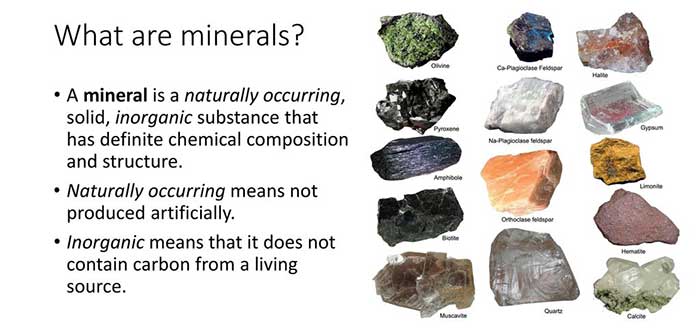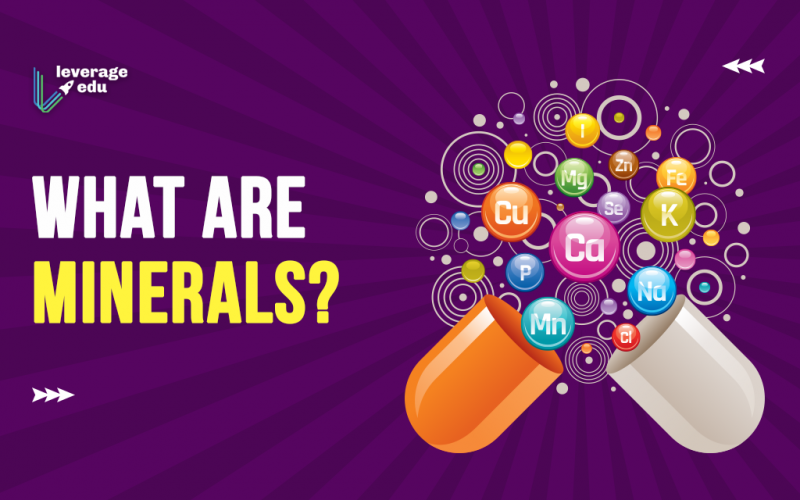When we come across objects that are made of gold, silver, or other such elements, we rarely think about the science behind these elements and how they are discovered by humans. Have you wondered about the atoms, ions and molecules that combine to form these natural elements? These elements are present in food and on earth as well. The forms of these elements are different in food and earth substances. Are you perplexed about what are minerals and curious to know more about them? Then, you have come to the right place. In this blog, we shall discuss some of the basics of minerals, their uses, and their type.
http://cbseacademic.nic.in/web_material/CurriculumMain22/SrSec/PhysicalEducation_SrSec_2021-22.pdf
Also Read: Land, Soil, Water, Natural Vegetation and Wildlife Resources
Minerals
Minerals are inorganic solids that exist naturally and have a specific chemical composition and atomic structure. All of their physical properties are derived from this foundation. A rock, for example, is a body of undifferentiated mineral stuff or a combination of one or more minerals. Granite, basalt, limestone, and sandstone are all common rocks.

Physical Properties
Minerals are easy to identify based on their physical properties. They have unique physical characteristics. Here are their physical properties:
- Hardness means resistance to scratch
- Tenacity means resistance to impact
- Specific gravity means relative density
- Cleavage is the tendency of some crystals to split along planes of the weakest atomic bonding
- Magnetism
- Electrical Conductivity
- Acid Reactivity
Also Read: World Oceans Day
Classification of Minerals
Minerals are divided into two categories: primary and secondary. Minerals created by the volcanic process, which involves the cooling of liquid materials called magma, have been classified as primary, whereas those formed by other processes have been classified as secondary. Primary minerals such as olivine, anorthite, and hornblende, had entirely decomposed, and the byproducts recombined to create secondary minerals.
Crystal Structure
If you want to utilize the most efficient way to classify them then you should try implementing the crustal shape observation process. Usually, they adapt the shape of crystalline solid which is made up of an orderly repeating pattern of constituent atoms, molecules or ions which ends up extending the spatial dimensions. In case, you come across such structures then it is most probably a mineral. Until now there humans have discovered only 7 delimited groups of crystals systems in nature.
Also Read: What is Food Chain?
Rocks and Minerals
An aggregate of minerals that do not require to have a specific composition is rocks. Rocks can be composed of only one or more than one mineral. Limestone is one such rock that is composed of only a single kind of mineral in its entirety known as mineral calcite. On the other hand, rocks like granite are a mixture of more than one mineral such as feldspar minerals, quartz, and mica.
Also Read: Mineral and Power Resources Class 8
Examples of Minerals
We have covered minerals and their physical properties will help you identify them better. Here are examples that will help you understand the concept in-depth. We are surrounded by them in many forms. Check out the examples:
- Minerals include gold, diamonds, rock salt, and graphite used to form pencil lead
- Sodium chloride is the mineral that makes up table salt because it occurs in crystals shaped like little cubes, it has an organized structure
- Quartz, also known as silicon dioxide, is another common mineral. The hexagonal shape of its crystals is unique. Coal is a carbon-based material that was first captured by living beings through the process of photosynthesis
- Limestone is a type of rock made up of only one mineral: calcium carbonate. Igneous, sedimentary, and metamorphic rocks can be separated into three types based on their origin on Earth
Different Types of Minerals
The chemistry and crystal form of minerals are used to classify them. Metallic minerals and Non-metallic minerals are the two sorts of minerals:
Metallic
Metallic minerals have a lustrous appearance and a chemical composition that includes metals. They have the potential to be used as a metal source and can be mined. Metallic minerals include the following: manganese, iron ore, and bauxite, which are classified as ferrous or non-ferrous. Non-ferrous minerals are those that do not contain iron, while ferrous ones do.
Also Read: Speech on Blood Donation
Non-metallic
Minerals that have a non-metallic sheen or shine to them are known as non-metallic minerals. Their chemical composition does not contain any extractable metals. Non-metallic minerals include limestone, gypsum, and mica. For example, Bauxite ore is found largely in worn rocks. In some areas, bauxite deposits can be found in volcanic rocks.
Minerals in Food
Do you know our food items are rich in various vitamins and minerals? Here are some of the minerals found in food items:
Calcium
When it comes to your bones, calcium is the most important macromineral. It contributes to the development of strong bones, allowing you to perform tasks such as standing up straight and scoring the game-winning goal. It also helps in the development of strong, healthy teeth, which are necessary for chewing delectable foods.
- Milk, cheese, and yogurt are examples of dairy products
- Leafy green vegetables, such as broccoli, tinned salmon, and sardines with bones
Iron
Iron is required by the body to transfer oxygen from the lungs to the rest of the body. To stay healthy and alive, your entire body requires oxygen. Iron helps in the synthesis of haemoglobin the component of red blood cells that transports oxygen throughout the body.
- Meat
- Beans
- Tuna and salmon
- Dried fruits like raisins
- Eggs
- Baked potato with skins

Potassium
Potassium is necessary for the normal functioning of your muscles and nervous system.
- Citrus fruits like oranges
- Low-fat milk and yogurt
- Bananas
- Tomatoes
- Potatoes and sweet potatoes with skins
Zinc
Zinc is beneficial to your immune system, which is your body’s defence system against illnesses and infections. It also promotes cell growth and helps in the healing of wounds such as cuts.
- Legumes, such as beans, split peas, and lentils
- Nuts, such as cashews, almonds, and peanuts
- Beef, pork, and dark meat chicken
Also Read: Human Resources Class 8
Common Minerals found in Igneous Rocks
| Minerals | Chemical Composition | Appearance | |
| Quartz | Silicon Dioxide | Glassy, clear, cloudy, white, grey, pink | |
| Feldspar | Plagioclase | Calcium or sodium aluminium silicate | Blocky, dark grey to white |
| Orthoclase | Potassium aluminium silicate | Blocky Pink | |
| Mica | Biotite | Complex iron silicates | Thin, shiny black sheets |
| Muscovite | Complex Potassium Silicates | Thin, shiny clear sheets |
Practice Questions
Here are some practice questions to test yourself and see how familiarized you are with the concept of minerals:
Q1. What are minerals?
Ans. Minerals are substances that occur naturally on the planet. They’re putting together rock blocks. Minerals are inorganic solids with a crystal structure that are generated naturally by geological processes. Mineralogy is the study of minerals.
Q2. What are the benefits of minerals?
Ans. Minerals, like vitamins, aid in the growth, development, and maintenance of your body. Minerals are used by the body for a variety of purposes, including the formation of strong bones and the nervous system development. Some minerals are also required for the production of hormones and the maintenance of a regular heartbeat.
Q3. What are four mineral science sources?
Ans. The elements oxygen, silicon, copper, iron, calcium, sodium, potassium, and magnesium make up about 99 per cent of the minerals in the Earth’s crust. Quartz, feldspar, bauxite, cobalt, talc, and pyrite are all common minerals.
Q4. Which mineral is the most common in the human body?
Ans. Calcium is an essential mineral in the human body, accounting for 1.5 to 2% of the total body weight. An adult human’s body has approximately 1,200 g of calcium, with bones accounting for nearly all of it.
Q5. Is salt considered a mineral?
Ans. Salt, often known as rock salt or halite in its natural form as a crystalline mineral, is a mineral consisting primarily of sodium chloride (NaCl), a chemical compound belonging to the wider class of salts. Seawater has a large amount of salt, which is the principal mineral element.
FAQs
Minerals are substances naturally formed on the Earth. Minerals are typically solid, inorganic, have a crystal structure and are formed by geological processes naturally. A mineral may consist of a single chemical element or a compound more usually.
Salt is a mineral composed mostly of sodium chloride (NaCl), a chemical compound belonging to the broader class of salts; salt is known as rock salt or halite in its natural form as a crystalline mineral. Salt is present in vast amounts in seawater, where it is the main constituent of minerals.
Minerals can be found in foods such as cereals, bread, meat, fish, milk, dairy, nuts, fruit and vegetables (especially dried fruit). We need more than others, of some minerals. We need more calcium, phosphorus, magnesium, sodium, potassium and chloride, for example, than iron, zinc, iodine, selenium, and copper do.
Like vitamins, minerals help your body grow, evolve and remain healthy. The body uses minerals to perform many functions — from building strong bones to nerve impulse transmission. Some minerals also create hormones or hold a regular heartbeat.
Minerals are the nutrients that reside in the body and are as important to sustaining life as our need for oxygen. Minerals are also found in the food is organic and inorganic combinations. Just 5 per cent of the weight of the human body is mineral matter in the body, essential to all mental & physical processes & for complete well-being.
We covered some of the basics of minerals, what are they, their physical properties, classification of these elements, their presence in food, and some practice questions. For the latest updates around study blogs, you can follow us on Instagram, Twitter, Facebook & also subscribe to our newsletter. Leverage Edu wishes you all the best for all your future endeavours.

 One app for all your study abroad needs
One app for all your study abroad needs





















 45,000+ students realised their study abroad dream with us. Take the first step today.
45,000+ students realised their study abroad dream with us. Take the first step today.

